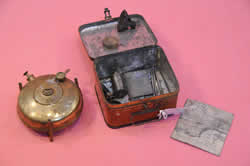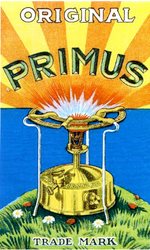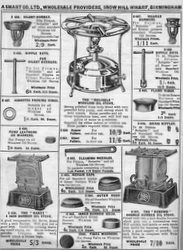
The Scottish Mountain Heritage Collection
Objects Database
Primus No 100 Paraffin Stove
Accession Number
630.2008.1(a-p)
Object Name
Primus No 100 Paraffin Stove
Created
08/12/2008
Creator
Hermione Cooper
Accession Date
08/12/2008
Brief Description
Brass 'Primus' stove, with fourteen associated parts and instructions for use sheet, in original red metal box. Screwtop lid for refuelling, pump and screwtop for burner. Three cylindrical holes for removable pot rests. Box has hinged metal carrying handle.
Materials
metal, paper
Dimensions
Box - 11(h) x 20(w) x 17.5(d) cms.
Number Of Objects
1
Inscription Description
On top of box "PRIMUS" a picture of a stove "TRADE MARK" On stove "TRADE MARK PRI(picture of stove)MUS NO 100" " PRIMUS A/BBA.HJORTH & CO. STOCKHOLM SWEDEN SOLE MAKERS OF THE GENUINE 'PRIMUS' APPARATUS" This is repeated in a number of different languages including Greek and Arabic.
Colour
gold, brown, red
Maker
A/BBA.HJORTH & CO.
Object Production Place
Sweden
Provenance
The Pressure Stove
The paraffin, (kerosene), pressure stove first appeared in 1892 when a Swede, Frans Wilhelm Lindqvist, registered his 'Sootless Kerosene Stove'. The design burned Paraffin gas which was vapourised from the liquid fuel in tubes forming the burner head. His design was so successful a Company was formed to manufacture the stove and
'Primus', (Latin for first), appeared to the World.
The first model was the No. 1 stove and the range rapidly expanded into many dozens of models aimed at different markets. With Amundsen using a 'Primus' to reach the South Pole and Hillary taking 'Primus' stoves to climb Mount Everest the word became used by many people to describe any
pressure camping stove. In 1962 the paraffin division of Primus was sold to Optimus but continued to manufacture stoves under the name 'Primus Trading'.
The Company was closed in 1972 and the range consolidated just to Optimus models.
In 1966 Primus joined with one of their rivals, Sievert, and concentrated on L.P.G., (Liquified Petroleum Gas), camping stoves as well as blowlamps. In 1997 Primus re-entered the liquid fuel stove market with some excellent designs of multi-fuel stoves still available today.
The Optimus Company had also been making a range of stoves since the late 1890's and continued the traditional paraffin stove right up to 1996 when the range was gradually withdrawn to concentrate on the range of Petrol, (Gasoline), and multi-fuel stoves manufactured today.
The basic Lindqvist burner design was copied by manufacturers all over the world, many adopting the same method of numbering their models by the burner size and style, ie. 00, Nol, No5.
This variation in models makes stoves appealing to collectors, some prefer to find one model from many different manufacturers, some try to collect every model from one manufacturer. Further interest is added by long running models 'evolving' over the years.
A glance down a list of some brands shows the wide choice such as Monitor, Burmos,Parasene, Buflam, Valor, Royal Standard, Thermidor, Kenrick, (U.K.), Optimus. Radius,Primus, Svea, Prince, (Sweden), Coleman,(U.S.A.), Meva, (Czechoslovakia), Metacel,(Australia), Petromax, (Germany), Hipolito, (Portugal), Anchor, Shinabro, (China),Manaslu (Japan).
Acquisition Date
08/12/2008
Condition Check Date
28/04/2009
Rules
Spectrum : UK Museum documentation standard, V.3.1 2007
Modified
28/04/2009



